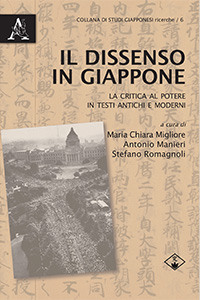Estratto da
IL DISSENSO IN GIAPPONE
La critica al potere in testi antichi e moderni
La rappresentazione del dissenso nei drammi proletari di Murayama Tomoyoshi
IL DISSENSO IN GIAPPONE
La critica al potere in testi antichi e moderni
La rappresentazione del dissenso nei drammi proletari di Murayama Tomoyoshi

While early voicing of performed political dissent in pre-war Japan can be traced back to the beginning of the Meiji era, the most organized and articulate expression of such dissent was undoubtedly achieved within the proletarian theatre movement of the late 20s. One of its prominent playwrights was Murayama Tomoyoshi, whose efforts to transpose the most recent viewpoints about proletarian realism into play gave birth to some of the most significant dramas of those years. In this paper I analyse his four major proletarian plays: ‘Bōryokudanki’ (1929), ‘Shōri no kiroku’ (1931), ‘Tōyō sharyōkōjō’ (1931), and ‘Shimura Natsue’ (1932), arguing that they show an overall evolution of the representation of dissent vis-à-vis the changing ideological stances on proletarian art. In the search for a synthesis between content, form and ideology, Murayama shows his audience not only the way in which the expression of dissent is democratically constructed, but also the necessity of dissent per se.
| pagine: | 133-170 |
| DOI: | 10.4399/97888548920026 |
| data pubblicazione: | Marzo 2016 |
| editore: | Aracne |








